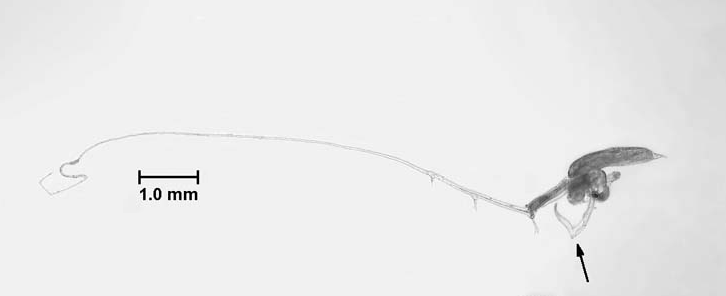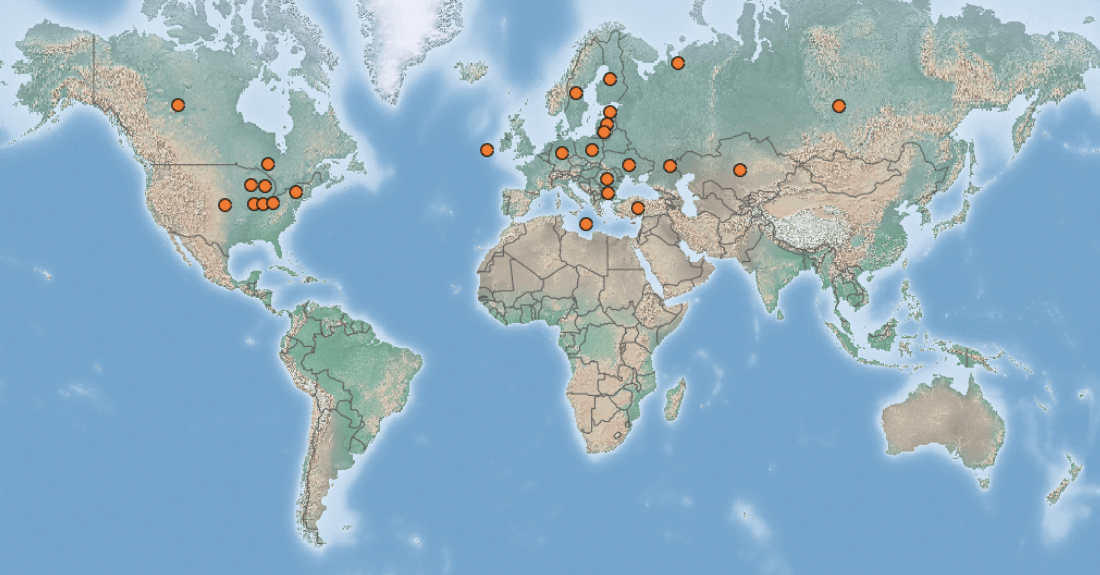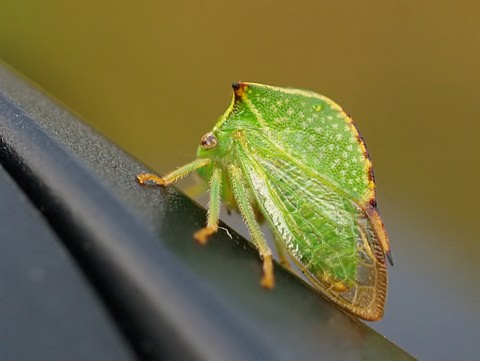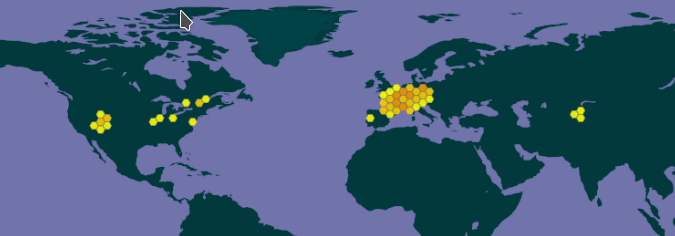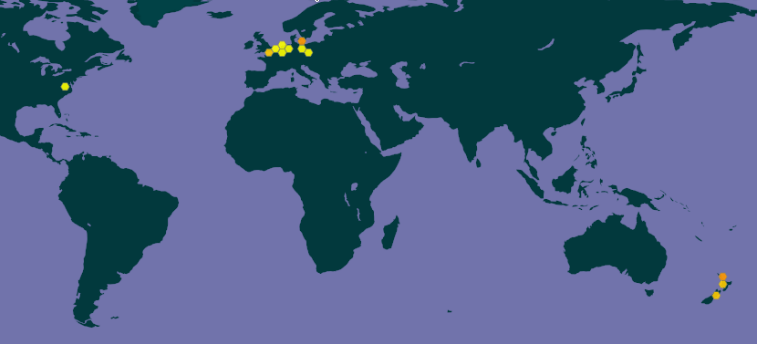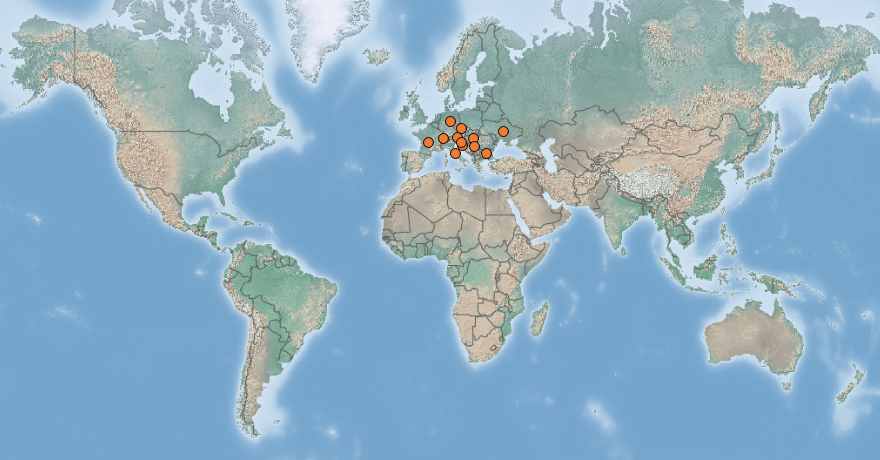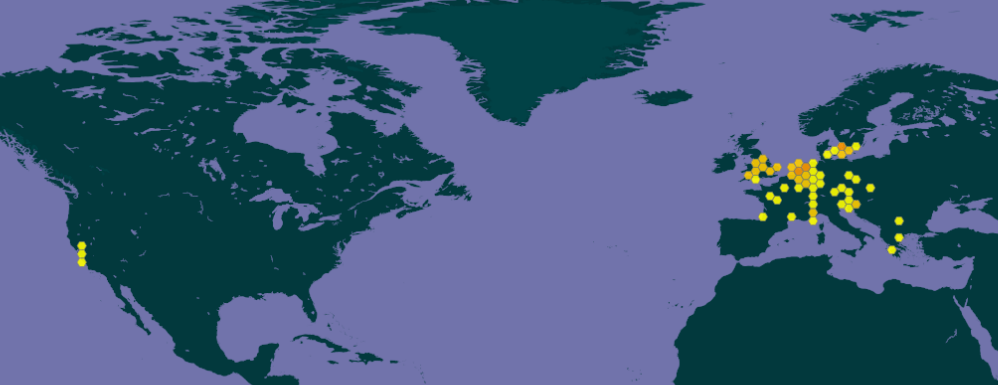 |
Asian black hornet |
Status LU: casual. 1st record: 2020. |
 |
Asiatesch Runn mat schwaarzem Thorax |
Status Eur.: established. IAS of EU concern (2016). |
 |
Frelon asiatique à thorax noir |
RA: ISEIA: C2. Harmonia+: 0.39. |
 |
Asiatische Hornisse |
Wikipedia:      | Wikispecies: | Wikispecies:  | CABI | CABI |
 |
Aziatische hoornaar |
Back to the list of invertebrates |
Brief description
 Vespa velutina nigrithorax du Buysson, 1905 (Hymenoptera: Vespidae) is a hornet of Asian origin which is a generalist predator of medium- to large-sized insects, and scavenger of vertebrate carrion. It has large impacts on Diptera and social hymenopterans, and in particular on honey bees (Apis spp.). It has recently been spreading in Asia (it is an invasive species in South Korea and Japan), and the subspecies V. v. nigrithorax has been accidentally introduced to Europe where it was first recorded from southern France in 2004 (Villemant et al. 2006a: 536, 2006b). Since then it has been found in Spain (2010; López et al. 2011), Portugal (2011; Grosso-Silva & Maia 2012), Belgium (2011, 2016; Barbier & Renneson 2018), Italy (2012; Federazione Apicoltori Italiani 2013), Germany (2014; von Orlow 2014), the Balearic Islands (2015; Leza et al. 2018), the Channel Islands (2016; States of Guernsey Government 2016), the UK (2016; Budge et al. 2017), the Netherlands (2017; Smit et al. 2017), Switzerland (2017; Ebener 2017), Luxembourg (2020; MNHNL, iNaturalist & GBIF, 2020). This invasive species can threaten honey production and native pollinating insects. It may be introduced and transported accidentally with soil associated with plants, garden furniture and pots, timber, vegetables, camping equipment, etc. (CABI 2019).
Vespa velutina nigrithorax du Buysson, 1905 (Hymenoptera: Vespidae) is a hornet of Asian origin which is a generalist predator of medium- to large-sized insects, and scavenger of vertebrate carrion. It has large impacts on Diptera and social hymenopterans, and in particular on honey bees (Apis spp.). It has recently been spreading in Asia (it is an invasive species in South Korea and Japan), and the subspecies V. v. nigrithorax has been accidentally introduced to Europe where it was first recorded from southern France in 2004 (Villemant et al. 2006a: 536, 2006b). Since then it has been found in Spain (2010; López et al. 2011), Portugal (2011; Grosso-Silva & Maia 2012), Belgium (2011, 2016; Barbier & Renneson 2018), Italy (2012; Federazione Apicoltori Italiani 2013), Germany (2014; von Orlow 2014), the Balearic Islands (2015; Leza et al. 2018), the Channel Islands (2016; States of Guernsey Government 2016), the UK (2016; Budge et al. 2017), the Netherlands (2017; Smit et al. 2017), Switzerland (2017; Ebener 2017), Luxembourg (2020; MNHNL, iNaturalist & GBIF, 2020). This invasive species can threaten honey production and native pollinating insects. It may be introduced and transported accidentally with soil associated with plants, garden furniture and pots, timber, vegetables, camping equipment, etc. (CABI 2019).
Further invasions are expected in various countries covering much of Europe.
IAS of Union concern
In 2016, Vespa velutina nigrithorax du Buysson, 1905 was added to the list of invasive alien species of Union concern (Anonymous 2016) which implies that member states shall take all necessary steps to prevent it’s unintentional introduction or spread.
Status and distribution in Luxembourg
Vespa velutina nigrithorax du
Buysson, 1905 was first recorded in the wild in Luxembourg by Thierry Helminger on 2
nd September 2020: a few individuals on grapes from a vine in a garden (Helminger 2020, Ries et al. 2021).
Before that, in August 2012, the alleged first observation of Vespa velutina in Luxembourg was published in a daily newspaper, which turned out to be wrong, as it contains photos of V. crabro (Back 2012b). 11 days before, the same journalist had already published an article about this Asian hornet species in Belgium (Back 2012a).
At the end of 2021, 28 records of the Asian black hornet in Luxembourg were accessible through the MNHNL-mdata portal (MNHNL, iNaturalist & GBIF 2020). As was to be expected, the number of observations shows a increasing tendency.
Photo gallery
Risk assessment
ISEIA protocol
Following its discovery in Luxembourg on 2nd September 2020, the species has been reassessed on 3rd September to C1 (3+1+1+1) by Christian Ries. It has to be considered as C2 by now. Assessment before the appearance of the species in Luxembourg: C0 (3+1+1+1) (Ries et al. 2017: 69).
Harmonia+ protocol
Overall risk score 0,39 = (Overall Invasion score 0,72 x Overall Impact score 0,55) (Ries et al. 2021: 187-188).
0,72


Invasion
0,55


Impact
0,39


Risk
Worldwide distribution
Outreach
Between the publication of the leaflet in 2016 (DE) and 2017 (FR) and the first observation of the Asian black hornet in Luxembourg on 2020/09/02, 18 reports were sent to the authorities, mostly mistaken for the native Eurasian hornet. 29 reports were sent between the first observation (2020/09/02) and the press release (2020/09/28), 12 were correct. After the press release, 103 reports were sent to date (2020/11/24), of which 11 were indeed reporting the Asian black hornet.
Of the 151 reports of Vespa velutina nigrithorax, 23 were correct and 19 reports without photo or specimen could not be validated. In the remaining reports, the following species have been mistaken for the Asian black hornet: Bombus sp. (1x), Dolichovespula saxonica (1x),Dolichovespula sp. (1x), Polistes dominula (6x), Polistes nimpha (1x), Tabanus bovinus (2x), Vespa crabro (63x, the native Eurasian hornet), Vespula germanica (31x), Vespula sp. (1x), Volucella zonaria (2x; the hornet mimic hoverfly).
Press release (2020-09)
Press release of 28 September 2020: “First detections of the Asian black hornet in Luxembourg” (FR & DE)
Poster (2022-01)
In 2022, the Luxembourg Nature and Forestry Administration has published a poster to help differentiate between the Asian Black Hornet (Vespa velutina nigrithorax) and the Native Hornet (Vespa crabro).

Leaflets
Updated leaflets (November 2020)


Old versions (2016, 2017)
In spring 2016 the Department for the Environment of the Luxembourg Ministry of sustainable development and infrastructures published a leaflet in German about Vespa velutina, in co-operation with the Nature and Forestry Administration, the National Museum of Natural History, natur&ëmwelt and the national bee-keeping association. A French version was produced in spring 2017. It can be downloaded here in PDF format (~400KB each).


Links
References
- Anonymous, 2016. Commission implementing regulation (EU) 2016/1141 of 13 July 2016 adopting a list of invasive alien species of Union concern pursuant to Regulation (EU) No 1143/2014 of the European Parliament and of the Council. Official Journal of the European Union L 189: 4-5.
- Back, A., 2012a. Bienenfresser aus Fernost. Wallonien rüstet sich gegen die Asiatische Hornisse, Luxemburg blieb bislang verschont. Tageblatt 180, 2012-08-03: 7. [JPG]
- Back, A., 2012b. Bienenfresser aus Fernost, Teil II. Asiatische Hornisse auch in Luxemburg angekommen. Tageblatt 189, 2012-08-14: 14. [JPG] [Note: This article in a daily newspaper about the arrival of Vespa velutina in Luxembourg is wrong, as it shows photos of V. crabro.]
- Barbier Y. & J.-L. Renneson (2018) Vespa velutina Lepeletier, 1836. Atlas Hymenoptera. URL: http://www.atlashymenoptera.net/pagetaxon.asp?tx_id=3877 [2018.01.03]
- Budge G.E., J. Hodgetts, E.P. Jones, J.C. Ostojá-Starzewski, J. Hall, V. Tomkies, et al., 2017. The invasion, provenance and diversity of Vespa velutina Lepeletier (Hymenoptera: Vespidae) in Great Britain. PLoS ONE 12(9): e0185172. https://doi.org/10.1371/journal.pone.0185172
- CABI, 2019. Vespa velutina [text by Sarah Bunker, UK; CRCNPB Australia]. In: Invasive Species Compendium. Wallingford, UK: CAB International. URL: www.cabi.org/isc [accessed 2020-01-31]
- Ebener, A., 2017. Arrivée du frelon asiatique en Suisse. Communiqué d’apiservice. URL: https://ffa-vfb.ch/2017/04/26/apiservice-arrivee-du-frelon-asiatique-en-suisse/
- Federazione Apicoltori Italiani, 2013. Vespa velutina: prima segnalazione in Italia. E’ allarme!. Rome, Italy: Federazione Apicoltori Italiani.
- Grosso-Silva J.M. & M. Maia, 2012. Vespa velutina Lepeletier, 1836 (Hymenoptera, Vespidae), new species for Portugal. In: Arquivos Entomolóxicos, 6 53-54.
- Helminger, T., 2020. Personal communication by e-mail to C. Ries on 3rd September 2020.
- Leza M., M. Á. Miranda & V. Colomar, 2018. First detection of Vespa velutina nigrithorax (Hymenoptera: Vespidae) in the Balearic Islands (Western Mediterranean): a challenging study case. Biological Invasions. 20 (7), 1643-1649. https://link.springer.com/article/10.1007/s10530-017-1658-z DOI:10.1007/s10530-017-1658-z
- López, S., M. González & A. Goldarazena, 2011. Vespa velutina Lepeletier, 1836 (Hymenoptera: Vespidae): first records in Iberian Peninsula. Bulletin OEPP/EPPO Bulletin. 41 (3), 439-441.
- MNHNL, iNaturalist & GBIF, 2020. Vespa velutina nigrithorax du Buysson, 1905 in MNHNL-mdata, online portal combining species observation from Recorder-Lux, iNaturalist and GBIF. National Museum of Natural History, Luxembourg. URL: https://mdata.mnhn.lu [Accessed 2020-09-18]
- Proess, R., 2021. Plan d’action pour espèces exotiques envahissantes au Grand-Duché de Luxembourg : le Frelon asiatique à pattes jaunes (Vespa velutina nigrithorax du Buysson, 1905). Version de janvier 2021. Plan élaboré pour le compte de l’Administration de la nature et des forêts, Luxembourg. 24 pp.
- Renneson, J.-L. & N. Schneider, 2020. Rapport de visite de terrain – recherche du frelon asiatique à Junglinster. Rapport non-publié du 06/09/2020, Marbehan.
- Ries, C., A. Arendt, C. Braunert, S. Christian, A. Dohet, A. Frantz, G. Geimer, M. Hellers, J. A. Massard, X. Mestdagh, R. Proess, N. Schneider & M. Pfeiffenschneider, 2017. Environmental impact assessment and black, watch and alert list classification after the ISEIA Protocol of invertebrates in Luxembourg. Bull. Soc. Nat. luxemb. 119: 63-70. [PDF 360 KB]
- Ries, C., N. Schneider, F. Vitali & A. Weigand, 2021. First records and distribution of the invasive alien hornet Vespa velutina nigrithorax du Buysson, 1905 (Hymenoptera: Vespidae) in Luxembourg. Bulletin de la Société des naturalistes luxembourgeois 123: 181-193. [PDF 3 MB]
- Smit J, R van de Roer, R Fontein & A de Wilde (2017) Eerste vondst van de aziatische hoornaar Vespa velutina nigrithorax in Nederland (Hymenoptera: Vespidae). Nederlandse Faunistische Mededelingen 49: 1-10.
- States of Guernsey Government, 2016. Asian hornet identified in Alderney., https://www.gov.gg/article/155332/Asian-Hornet-identified-in-Alderney
- Villemant, C., J. Haxaire & J.-C. Streito, 2006a. Premier bilan de l’invasion de Vespa velutina Lepeletier en France (Hymenoptera, Vespidae). Bulletin de la Société entomologique de France 111 (4): 535-538. [PDF]
- Villemant, C., J. Haxaire & J.-C. Streito, 2006b. La découverte du frelon asiatique Vespa velutina, en France. In: Insectes, 143 (4) 3-7. [PDF]
- von Orlow, M., 2014. Asiatische Hornisse hat Deutschland erreicht. Nachweis bei Karlsruhe / Imker befürchten Schäden an Bienenvölkern. URL: https://www.nabu.de/news/2014/09/17045.html
Page content last updated on 2024-03-06. Last proofread by Caroline Grounds on 2019-12-12.






 | Wikispecies:
| Wikispecies: 

